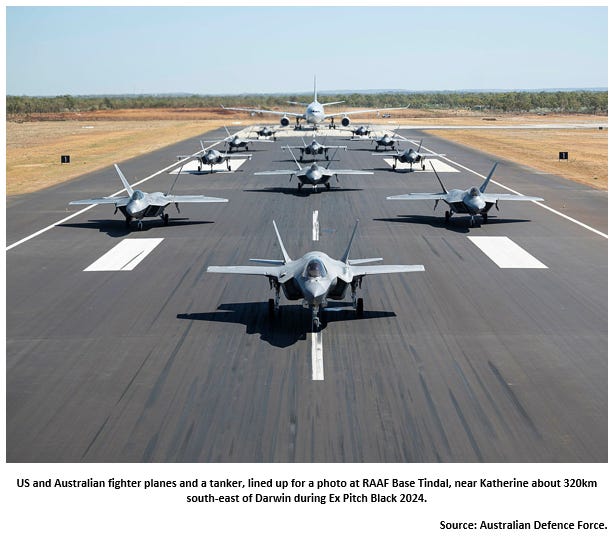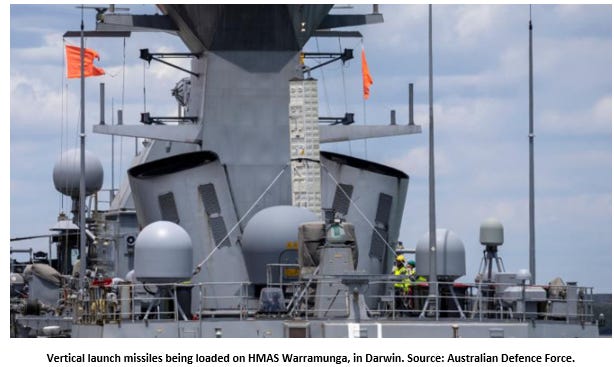Pacific Brief 29 September 2024
Northern Australia’s militarisation
Currently, a key feature of security discussions in the Pacific is the militarisation of Australia’s north. Australian and the US investing in Australia’s capacity to support its allies in the region. An investment the Australian Broadcasting Corporation (ABC) recently reported in an article titled ‘Australia’s northern neighbours cautious over US military build-up in Northern Australia’ is concerning for some neighbouring countries.
US bases in Australia are getting bigger and more well-equipped. The ‘US Force Posture Initiative’ is an American plan to spend between $ 490 million and $ 970 million upgrading and expanding RAAF bases in Darwin and Katherine, including building barracks, command centres and hangars.
The US is already annually rotating forces into Northern Australia including roughly 2,500 US Marines and B-52 bombers. It is also noteworthy that Australia is hosting more, and bigger exercises, including Exercises Talisman Sabre, Pitch Black, Kakadu, and Predator's Run. For instance, the first Exercise Talisman Sabre in 2005 involved only Australia and the US, but the next one in 2025 will involve 19 nations. This year’s Exercise Pitch Black provides another example of the increasing size and complexity of exercises in Northern Australia, involving thousands of personnel and 140 aircraft from 20 nations. Dozens of aircraft flying from Europe to support the exercise.
Essentially, Australia’s north is experiencing an enormous build up of military infra-structure required to support not only Australian forces but also other allies and partners. Additionally, the capabilities to deploy and work together are regularly rehearsed. Exercises allowing participating nations to practice inter-operability, testing the systems and communications needed to fight effectively together.
This is an international trend, the US working to build alliances and partnerships with like-minded nations, including Australian. Recently, the International Institute for Strategic Studies (IISS) published its ‘Asia-Pacific Regional Security Assessment 2024’ highlighting the large number of international exercises the US has led in the Asia-Pacific region. The report records 1,113 US led international military exercises between 2003 and 2022. It compares this figure with the 128 China conducted in the same period. IISS identifies Australia, Indonesia and India and the US’s most important exercise partners.
In the Pacific region, Australia is developing as a key location for US led deterrence. The nation’s large land area provides ample room for facilities, infrastructure and exercises. Further, the country has the civilian infra-structure to support large international deployments. Roads, hospitals and a defence industry are all important considerations for supporting force projection. Australia could provide either a launch pad for an intervention in the South West Pacific or second-line support for operations in places like Taiwan, Korea or the South China Sea.
US forces fighting in these places can be supported from the US mainland via Hawaii via bases in Micronesia, Japan and Philippines. However, having a large and capable logistics hub in Australia provides a second option, spreading risk in an age of long-range missile and drone attacks. Further, between them Australia and Indonesia secure an alternative maritime supply route from the Indian Ocean to the Pacific via Melanesia, in case the Strait of Malacca or South China Sea is compromised.
However, the ABC article notes concern about this policy in neighbouring countries, discussing Indonesian international relations analyst Dinna Prapto Raharja’s commentary that raises concerns about Australia’s emphasis on Sino-American competition. She emphasises Indonesia’s policy of non-alignment and the nation’s focus on economic development rather than security. Indonesia’s focus is not containment of China, or competition but developing its economy and a competitive, security focussed strategy may not be supported.
This juxtaposition between the US, Australia, and its neighbours is not new, and is a potential cause for concern because it could undermine collective security. If the US and Australia are perceived to be focussed only on Sino-American military competition, they risk losing the collective support from other Pacific nations. For instance, several members of the Pacific Islands Forum protested the AUKUS submarine deal, and the forum continues to reinforce that it is focussed on development rather than Sino-American competition.
Strategically, balancing these perceptions against the need to deter aggression is a key issue for nations supporting the current ‘rules-based order.’ Currently, Chinese coast guard vessels are aggressively policing that nation’s unilateral claim to the South China Sea. Utilising physical force and the threat of violence to achieve a diplomatic objective. The key deterrent against these tactics being employed elsewhere in the region, or the situation escalating in military confrontation is credible military deterrence. But, to be successful deterrence requires a collective commitment.
Australia and the US are investing in deterrence and it is important to remember that deterrence is not aggression. Military infra-structure and training is required to provide a credible deterrent, but it can be perceived as threatening. Therefore, it is important that the US and Australia acknowledge the concerns of other nations, and work to address them before they become a ‘wedge’ between potential collective security partners.
Japan considers regular rotations of soldiers and aircraft to Australia
An indication of how much the world has changed in the last century is a recent announcement that Japan is considering regular rotations of soldiers and aircraft to Australia. In World War Two, Australia was nearly invaded by Japan, and Darwin, the city that will host Japanese forces was bombed by Japanese planes.
The defence and foreign ministers of Japan and Australia, met in early September and discussed a range of security issues, committing to several actions designed to strengthen defence ties, and the regional economy. The commitments included deployment of Japanese liaison officers to Australia and arranging for more integrated training.
Already, Japanese and Australian fighter aircraft are exercising regularly in each other’s countries and there are also reports that the two nations will work together to bring the Tomahawk cruise missile into service. Japan using Australian ranges to exercise Tomahawk cruise missiles and both countries working together to bring the weapon into service, integrating their processes, procedures and technology to fight together, on in military terms becoming ‘inter-operable.’
Since then, Australian Defence Minister, Richard Marles has discussed a plan for soldiers from the Japanese Amphibious Rapid Deployment Brigade to regularly participate in the US Marine Corps Programme of annual rotations to Northern Australia. Minister Marles stating "We have agreed to explore ways in which the Japanese Amphibious Rapid Deployment brigade can participate in the US Marine rotations, which occur in Darwin every year." And Japan’s Foreign Minister, Kamikawa Yoko has also discussed the two countries plans to increase cooperation, citing the unpredictable strategic environment.
It is also reported that Japan and Australia are discussing the potential for similar rotations of fighter aircraft to Australia. Although Japan’s Defence Minister, Kamikawa Yoko stressed that this idea is only being consulted on, at this stage.
This is an interesting trilateral development, the US, Australia, and Japan working together to improve their inter-operability, and potentially force redundancy. Currently, the US, Australia, and Japan are all deeply concerned about the situation in the South China Sea, supporting US ally Philippines. Marine forces for littoral operations, long-range missiles and airpower are all key operational capabilities that would be required to fight a war in, or around the South China Sea.
Any war requires logistics, and Japan relies on trade from the Indian Ocean. If the South China Sea is closed, Australia provides a base for operations to secure alternative routes through Melanesia. Additionally, Australia provides large areas for dispersed logistics hubs that provide redundancy for military supply lines into a conflict in the South China or East China Sea. Traditionally, the US would support forces in Asia via Hawaii, Micronesia, Philippines and Japan all of which are likely be targeted in a future ‘peer conflict.’ Australia’s distance and large size makes it harder to target facilities located there so it provides logistics redundancy. Further, Japanese fighters based in Australia are less likely to destroyed in pre-emptive strike.
The discussion between Japan and Australia, is important and worth watching because it provides insight into just how concerned these nations are about Chinese activity, and about their plans to deter aggression.
Australia practices re-arming US and Canadian ships
Last week, in Darwin and Broome, the Australian navy practiced re-arming the missiles on US and Canadian warships. Re-arming a ship with expensive and dangerous missiles is a difficult operation. An activity that needs to be rehearsed in peace-time if it is to be conducted during conflict and re-loading US Arleigh-Burke-class destroyer USS Dewey and Canadian Halifax-class frigate HMCS Vancouver provided an opportunity to test, and confirm the skill with foreign navies.
This activity is another indication of the growing level of inter-operability between Australia and its allies and partners. Recent conflict in the Red Sea, demonstrates how quickly air-defence missiles can be expended even in an asymmetric conflict, and vertical launch missiles need to be reloaded in port. So, it is important that these skills are tested and rehearsed as close as possible to potential operational areas. Australia’s strategic security focus on the north, means this capability is being developed in Broome and Darwin, both cities located to support operations in this area.
Melanesian update
A regular update on the Pacific’s least reported trouble spot; Melanesia.
Australia Refurbishes Cook Barracks in Vanuatu
Australia has just finished refurbishing and modernising Vanuatu’s Cook Barracks. The project started in 2021 and includes a range of facilities like a medical centre that will contribute to civilian response to natural disasters. The project is a good example of Australia providing support to a neighbouring nation, and how it is using ‘soft power’ to build diplomatic influence in Melanesia.
Fiji releases foreign policy White Paper
This week Fiji released a White Paper discussing foreign policy. The document reinforces Fiji’s commitment to maintaining a peaceful Pacific. Noteworthy is the Prime Ministers introduction that discusses a “long transition from the US-led liberal international order to a more multipolar world.” And, how this process leads to its replacement with “a complicated competition for primacy between the US and China, played out most sharply in our Indo-Pacific region.” An important indication of Fiji’s perspective on the evolution of global security issues.
Later the document provides useful insight into Fijian perspectives of how to manage this ‘transition’ including highlighting the importance of the Pacific Islands Forum. The paper stating that ‘’For Fiji the Pacific Island Forum (PIF) is the cornerstone regional institution. It symbolizes the unity and shared destiny of Pacific nations, centred around our one Ocean.” Important insight about how valuable the forum is to nations in the Pacific, an indication that successful engagement by the US and other powers seeking influence in the region needs to include this forum.
Here is a link to the document - https://www.foreignaffairs.gov.fj/wp-content/uploads/2024/09/FFPWP.pdf
New Zealand soldiers exercise with Fijian army. Papua New Guinea soldiers exercise in Australia
A group of New Zealand soldiers completed an intensive heavy weapons exercise with their Fijian counterparts this week. Meanwhile, in Townsville Papua New Guinea soldier were exercising with Australia’s 3rd Brigade. Two small but important examples of military ‘soft power,’ training and exercises being used to develop and strengthen international relationships.





